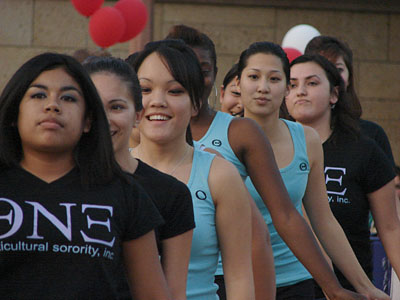 |
||||
|
Hispanic Female Education
Gender, Culture and Language in School Administration:
|
|
|||
|
|
||||

Implications for the Future As school districts continue to meet educational needs of the large influx of Hispanic students, more emphasis should be placed on hiring school administrators in key positions that better reflect the ethnicity and cultural identities of the student population. According to a 1991 article in the New York Times, Chancellor Joseph A. Fernandez of the New York City's Public School System pushed for increasing the number of Black, female, and Hispanic principals who could serve as role models for their students (Metropolitan News. p. B1 and B5). In 1995 the Chicago Public Schools had a total of 123 Hispanics in administrative positions, including facilitators, principals, assistant principals and regional officers. In 1996 that number grew to 140. Hispanic female principals made up 42 of the group in 1996 and Hispanic male principals made up a total of 27 of those numbers (1996). Results of this study point out that Hispanic female principals do not want to be considered "outsiders" by their colleagues; they seek entrance into leadership positions and acceptance by the majority culture. Condescending attitudes and tokenism, once they are detected, are destructive to positive working relationships. In seeking to "know thyself" or what their leadership styles are, it behooves all women to become knowledgeable about the majority culture in which they work. Women will play a significant role in the administration of education in the future, and more effort needs to be expanded in support of females in key leadership positions, including women of differing cultures and language, so that their successes can become the successes of American urban education. Editors' Note: APA style is followed as closely as possible using html. Indentions, spacing, and footnoting may vary.
References
Promoting Equity for Girls in Guatemala's Public Primary Education SystemBy Jennifer Johnson - 1997 Education for girls in developing countries is not an easy problem to tackle, since it takes money, time, and organization, not to mention support from the government and the immediate community. Guatemala's educational system is marked by uneven access, equity, and completion rates for girls. Rural indigenous girls seem to fare the worst. A program called Guatemala Girls' Education Initiative, a component of the Basic Education Strengthening Project (BEST), seeks to improve efficiency and reduce the repeating of grade levels and dropout rates for these girls throughout the country. This program is the first of its kind in Guatemala. This article will provide a status report of the current situation for the girls in Guatemala's public primary schools through a broad overview of the literature associated with the Guatemala Girls' Education Initiative. A brief orientation of the Guatemala Girls' Education Initiative within the broader Basic Education Strengthening (BEST) Project in Guatemala will be given. Next, a description of the status of education in Guatemala, especially for girls, will show the need for a specialized program. Different aspects of the Initiative will be outlined, including the goals, strategies, and components of the program. Finally, implications and findings of the program will be provided. Guatemala Geographically, Guatemala is the third largest Central American country at 108,889 square kilometers. At the outset of the Initiative, Guatemala's population was 8.6 million. The rural population is approximately 63 percent. Fifty percent of the indigenous population live in rural areas, constituting 73 percent of the total rural population (USAID, 1989, p. 11). The official language is Spanish, although 23 indigenous languages are spoken. To make communication even more difficult, geographic barriers caused by poor roads, and some 16,000 small, rural, mountainous satellite villages are difficult to access. USAID concludes that, because of Guatemala's inefficient educational system, diversity of languages and cultures, and inaccessibility of a large part of the population, "Solutions require consistently high levels of financial and political commitment over long periods of time" (USAID, 1989, p. 12). Guatemala has a high illiteracy rate, especially among the indigenous people, where 73 percent of the men are illiterate and 91 percent of the women are illiterate. In the labor force over the age of 15, about 87 percent have not completed primary school. About 25 percent of Guatemala's schools are one-room, one-teacher schools (Clay, 1991, p. 2). It is estimated that less than 60 percent of school-aged children were enrolled in school in 1980 (Gorman & Pollitt, p. 520). Guatemala has late starting ages of school children, a high dropout rate, repeated reentries into school, poor retention, and poor efficiency.
The Basic Education Strengthening (BEST) Project The Guatemalan Girls' Education Initiative is a subcategory in the larger educational project of Basic Education Strengthening (BEST) in Guatemala. BEST began with funds from United States Agency for International Development (USAID), which gradually became 'seed money' to encourage Guatemalan donors to take over the financial responsibility. The project was initiated and mobilized by USAID/Guatemala personnel, and later was taken over by Guatemalan public- and private-sector leaders. In 1989, the USAID/Guatemala project personnel created a Mission Education Sector Strategy to focus on public primary education. In addition, the Mission developed the BEST Program in cooperation with the Ministry of Education. The Mission initiated a series of activities to examine the relationship of girl's public school education in Guatemala to social and economic development. After initial investigation from literature reviews outside Guatemala, USAID/Guatemala decided that this was a topic for further investigation. An effort then was made to integrate girls' public education into the BEST project. The broad goal of BEST was to "improve the quality, efficiency, and equity of primary public education services in Guatemala" and to "institutionalize measures to improve the classroom environment, improve efficiency in the allocation and use of resources, and increase the equity of educational policies and practices" (USAID, 1993A, p. 1). The BEST Project originally started as a six-year project (1989-1995) that provided US$30 million to Guatemala's Ministry of Education (MOE) and was supported by an additional $31 million in counterpart funds. The timeframe has been extended to allow for system-wide, gradual change over the course of many years. BEST aimed to overcome long-term obstacles to education in Guatemala; however, short-term constraints had to be improved before moving toward long-term results. Thus, "project activities focused on the set of temporal priorities required for immediate improvements in the educational system, combined with a set of innovative delivery systems and analytic work designed to lay a foundation for future improvements in the financing, delivery, and management of basic education services" (USAID, 1993A, p. 1). BEST had four components: (1) bilingual education services for the Mayan-speaking population; (2) support services to improve classroom instruction; (3) research and development on low-cost alternative instructional methodologies (including girls' education); and (4) support for the improvements in the management and planning function of the Ministry of Education through the development of a computerized management information system, standardized achievement tests, and a research program (USAID, 1993A, p. 2). The Girls' Education Initiative was a subsection of component number three, 'low-cost alternative methodologies'. BEST had four major classroom innovations: (1) including bilingual education (PRONEBI); (2) multigrade active learning methodologies for learning schools (Nueva Escuela Unitaria); (3) incentives for encouraging girls to stay in school (Eduque a la Niña); and (4) a pilot project to integrate these three components (Clay, p. 1, 1996). The Guatemalan Economic, Political, and Social Environment Guatemala has suffered in all sectors from economic adjustments, poverty, political unrest and guerrilla warfare. Guatemala's basic structure and stability is in a state of recovery as a result. Gorman and Pollitt (1992) described this instability: Between 1954 and 1982, fourteen different presidents or governments were in power. Of these, all but two were headed by the military and only five were chosen through democratic elections. During that same period, the Ministry of Education in Guatemala was headed by 25 different Ministers comprised of ten lawyers, five military personnel, two medical doctors, a journalist, an economist, an engineer, a biochemist, a writer, two primary-school teachers and "a woman without a profession" (p. 520). During this period public education suffered. Improvements were needed in all areas of the public educational system. The rural areas had especially poor public educational services. Overall, the system was marked by inefficiency; widespread illiteracy; high dropout rates; poor management; poor teaching methods; materials that were outdated, inappropriate, or marginalizing; and many other problems. Guatemala began a democratically-elected national government in 1986, which has had a positive effect on the confidence in the government after years of political and economic instability. Economically, a downward economic spiral experienced by Guatemala in the early 80s appears to have ended with economic growth of 3.1 percent in 1987 (USAID, 1989, p. 11). These political and economic changes helped foster a more positive climate for development. These gains, however, have not spread to the marginalized members of the community, namely the highland indigenous people, the urban poor, and women. Typically, about 95 percent of the education budget has been used for teachers' salaries. A 1987 calculation showed that grade-level repetition cost 20 percent of the total Ministry of Education budget for that year (Clay, 1994, p. 3). Limited financial resources have not left much room for investing in improvements. Girls' Education in Guatemala A majority of girls in Guatemala are at the low end of an already poor public school system. A greater percentage of males than females are enrolled in primary school. Literacy rates favor males, and females typically leave school earlier than males. Ironically, males are more likely to fail than females. If the number of years in school is held constant, then the maximum grade attained is equivalent between the sexes (Gorman & Pollitt, pp. 532-533). This might be misleading by creating numbers that reflect a brighter picture than the reality. Nevertheless, girls consistently come out at lower levels in all levels of public education in Guatemala. USAID (1989) points out in its project description that girls are required to help out with domestic chores and child care more than boys. Because of scheduling problems from household duties, the girls are just too tired to complete homework or to participate in school regularly and meaningfully. A director of one school said that girls drop out more than boys because they are "too introverted; they are very reluctant to speak in class and do not interact in any positive manner", and blamed this on girls "innate cultural backwardness" (USAID, 1989, p. 13). Often girls are thought to have a lack of ability, without considering other factors contributing to poor school performance. A question to be answered is to what extent do the highland indigenous girls understand Spanish, if Spanish is used as the language of instruction. Perhaps this would influence their reluctance to speak. For the Guatemala Girls' Education Initiative, USAID/Guatemala needed to illustrate that education of girls would bring about positive change. Girls' education was identified as having a positive effect on the economy because without girls' education "the productive potential of much of the country's resources would not be brought to bear on Guatemala's development" (Clay, 1991, p. 1). Thus, the idea of education for girls became an economic issue early on. This will be discussed further in the implementation of the Initiative. Beginning Stages of the Guatemala Girls' Education Initiative Literature about girls' public education in Guatemala is basically nonexistent. USAID/Guatemala found that "The literature review indicated that a number of studies, theses, and projects had focused on women's education; however, no research or projects had focused specifically on girls' education and its relationship to any of the indicators of development" (Clay, 1991, p. 5). Despite a shortage of research, USAID/Guatemala generalized about girls' education in Guatemala and its effect on social and economic factors of development based on studies in other developing countries. The following conclusions were drawn, which were incorporated into the reasons why girls' education was important to incorporate into the BEST project * increased school attendance by girls produces long-term effects in reduced rates of illiteracy among adults; * increased school attendance by girls can produce medium-term (three to five years) effects by reducing fertility rates; * increases in the number of years that girls attend school yield cost savings for government and private sector entities in reduced expenditures; * increased school attendance by girls can produce long-term effects in improved agricultural and industrial productivity; and * increased school attendance by girls produces improved family well-being through improved knowledge of health and nutrition (Clay, 1991, pp. 6-7). USAID stressed that improvements in girls' enrollment, attendance, and achievement rates could only occur through intersectoral cooperation (Clay, 1991, p. 7). The multisectoral approach to this problem of girls' education stems from the obstacles that were out of reach of the Ministry of Education. These obstacles included poor roads or inaccessibility of schools, distance, and direct costs of education paid by the parents, including school fees, books, clothing, etc. Other obstacles included: * lack of child-care services, requiring older girls to stay at home; * economic constraints due to lost opportunity costs for girls' labor in domestic tasks; * inadequate public services of energy and water, requiring girls to search for and chop wood for cooking and to fetch water; * perceived irrelevance of the educational curriculum to the needs of girls and their families; and school schedules that conflict with harvest periods or family work schedules (Clay, 1991, p. 7). These constraints were recognized as problems faced by Guatemalan girls in attending public schools. These obstacles were beyond the jurisdiction of the Ministry of Education. The challenge was to integrate the many sectors to attempt to fix these barriers in a multisectoral cooperative effort. The Guatemala Girls' Education Initiative - Planning Strategies The USAID/Guatemala personnel anticipated resistance from private and public sector leaders and co-sponsors of the Initiative to the idea of education for girls, and therefore had clarifications, responses, and plans of action ready for the opposition. USAID made particular efforts to make this Initiative accepted and implemented. First, some individuals asserted that USAID was tampering with culture. USAID answered that "As a result of internal and external influences, cultures are dynamic and are in the process of continual change" (Clay, 1991, p. 10). Since change was inevitable, even with culture, USAID argued, at least planned change could be made into something positive (i.e., economic advancement for Guatemala via education for girls). Second, USAID wanted Guatemalans to assume leadership roles in this Initiative because "We knew that if girls' education was to take hold in Guatemala the movement would have to be led by Guatemalans, not by USAID, the United Nations (UN), or other international agencies" (Clay, 1991, p. 11). In achieving that end, USAID attempted to pull influential Guatemalan policy-makers to the cause. One way USAID attracted these top people was to find "highly qualified and motivated Guatemalans who could spearhead the planning and implementation" (Clay, 1991, p. 11). Then, USAID presented the Initiative to these policy-making people, who often became immediate supporters for girls' education, much to USAID/Guatemala's admitted surprise. USAID/Guatemala produced high quality materials and activities for the Girls' Education Initiative campaign, including the following: an elegant luncheon and dinner; a logo for the Initiative; personally delivered invitations; formal follow-up invitations; publicity documents; photo exhibition; media interviews; press announcements; and a formal reception at the Ambassador's residence (Clay, 1991, p. 17). Third, USAID made a conscious effort to remain in the background. They wanted Guatemala to make the Initiative theirs, not to think of it as a USAID idea. Also, USAID insisted that Guatemalans present the Initiative to other Guatemalans, not USAID personnel. USAID had many requests from USAID staff to present and market the Initiative, but USAID refused by saying that a USAID presence would be counterproductive for the promotion of the Guatemala Girl's Education Initiative. In the implementation process, USAIS encountered an obstacle that they had to overcome. The problem was that USAID identified lower fertility, better child and mother health, and later ages for first births to be a positive selling point in the aim to educate girls. They discovered, however, that whenever the issue of education's effect on reproduction came into the conversation, even the most ardent listeners would abruptly lose interest since the "subject of family planning was met with knee-jerk reactions" (Clay, 1991, p, 13). USAID learned that whenever the topic of family planning was brought up, the people closed off any possibility of further discussion of girls' education. The subject was too much of a social taboo. At first, USAID decided it was best to educate the Guatemalans about family planning. This failed to gain any constituents, so USAID "compromised our principles and excluded from the literature and discussions any reference to the relationship of girls' education to reductions in fertility rates" (Clay, 1991, p. 14). This bias against family planning threatened to cancel support for the Girls' Education Initiative. USAID reportedly was disappointed about abandoning this issue in the discussions and the literature, yet felt the overall mission of the project was more important. Finally, in keeping with the ultimate end goal of girls' education, USAID made strategic decisions about presenting the Initiative. First, they focused on economic development. USAID made it clear that their focus was social and economic development in Guatemala, not education and not women's issues. They did not allow the topic of equity to come into the discussion, reminding the listeners that the focus was exclusively on social and economic development. However, it is suggested that both education and women's issues are tied to social and economic development. In this vein, USAID never referred to women, only girls. They did this because they received negative reactions if women were mentioned and they "did not want to allow listeners the opportunity to draw these and other possible inferences concerning the effects of education on the lives of girls as they grow into women" (Clay, 1991, p. 17). USAID felt that when allowed to make the girl-to-woman connection, many Guatemalans became threatened as to the possibilities of what an educated woman might do. Little girls in public primary schools were not threatening, but grown educated women were. Cultural implications regarding the role various social institutions, such as the church, play in influencing this view were not discussed, but are certainly worth further consideration. To sell the Initiative, the discussion had to be limited to purely economic, social issues for Guatemala as whole. This meant that inequities or the oppression of women were not mentioned. USAID, in keeping with the goal of educating girls, seemed to describe the Initiative in whatever ways it would be accepted, and was successful in doing so. Guatemala Girls' Education Initiative - Components The Girls' Education Initiative was not an original part of the BEST Project but was added after the signing of the Project Agreement. The addition was made after extensive research and a literature review determined a specific need for a focus on girls' education. The research was conducted by AID/Washington. The USAID material does not indicate what prompted this post-signing research to support a move to include education for girls. Moving to the Girls' Education Initiative, as indicated earlier, research and a literature review conducted by AID/Washington showed that merely improving the quality and efficiency of the school system in Guatemala could not improve the difference in girls' and boys' attendance, retention, and completion rates in primary school (USAID, 1993, p. 53). Thus, separate action had to be taken for girls. At this point, specific pilot projects and actions emerged. One program, Franja Curricular, was a project that "focuses on qualitative changes in teachers' attitudes and classroom strategies, in curriculum materials, and in program development" (USAID, 1993, p. 54). Another program, Eduque a la Niña, was a "testing package of interventions" (USAID, 1993, p. 54). Eduque a la Niña, which was a model project of donor coordination, was established, to test the following educational actions: tutors; scholarships; teacher training; educational materials; social marketing; and others. Once tested, some of these newly tested and revised or improved activities were to be implemented in 21 Guatemalan highlands communities. The goals were to find the most cost-effective ways to promote retention and completion for girls. Components of the Initiative A discussion of the components of the Initiative follows. First, USAID wanted to create quality learning and teaching materials for girls in primary school. Seven full-time specialists were proposed to be hired in the areas of literacy text writers and curriculum. This would cost approximately $19 to $120 per child. The annual cost per student in Guatemala in 1992 was about $55. Despite doubts as to the cost-effectiveness of the project, it was supported and approved (USAID, 1993, p. 24). The Initiative can be divided into three broad categories of goals. The first category was the material and curriculum improvement, mentioned in the above paragraph. Second, the Franja Curricular and Eduque a la Niña projects, and third, the development and testing of innovations to retain girls in school and improve their achievement (USAID, 1993, p. 24). These three broad goals were implemented by the following activities: * seminars, fora, and presentations to the public and private sectors policy-makers to promote national level actions to address the barriers to girls' education; * support of the Ministry of Education in policy analysis and development through the analysis of research and findings on girls' education in Guatemala; * development of the Franja Curricular, including materials development and programs for integrating concepts, attitudes, and methods for improving girls' attendance and retention in primary school into all BEST project activities as well as all programs, materials, planning, and training of Ministry of Education personnel at all levels and in all regions; * development and coordination of Eduque a la Niña, a pilot program of 'packages of educational interventions' supported by seven public and private sector donors which will operate in 21 communities in three educational regions through technical assistance of FUNDAZUCAR; and * support to the Ministry of Education to design its Girls' Scholarship Program which was created by the Minister of Education in response to the policy initiatives of the BEST project Girls' Education Initiative. During the first year, the program will benefit 2,000 girls in four educational regions of the country (USAID, 1993, pp. 24-25). The Girls' Education Initiative was expected to provide 291 person-months of long- and short-term technical assistance. These positions include: * Local long-term director (30 months) * Local long-term deputy director (30 months) * Program administrator (30 months) * Local long-term project design specialist (6 months) * Two local long-term coordinators (30 months each) * Long-term instructional design specialist (30 months) * Curriculum coordination specialist (8 months) * Long-term editorial specialist (30 months) * Communication specialist (3 months) * Evaluation specialist (4 months) * Two curriculum writers (12 months each) * Graphic designer (4 months) * Eight curriculum trainers (4 months each), and * Administrative/management specialist (3 months). In addition, the Ministry of Education agreed to open two new professional positions dealing exclusively with education for girls. Finally, the Ministry of Education agreed to adding four coordinators and four supervisors to handle the Girls' Scholarship Program (USAID, 1993, p. 25). Involvement of FUNDAZUCAR FUNDAZUCAR, the Foundation for Sugar Producers, was selected in a competitive bidding process to implement the Eduque a la NiÒa project by coordinating the selection of bilingual public schools and implementation of Eduque a la Niña. FUNDAZUCAR was founded in 1990 and immediately became involved in community activities, including supporting girls' education. This Foundation is known in Guatemala for efficiently and effectively implementing projects on education, health, and infrastructure programs. Also, FUNDAZUCAR partially funded the research and the publication of Guatemala's National Plan of Action on Girls' Education (USAID, 1993a). FUNDAZUCAR and other participating institutions were expected to generate funds from private-sector groups within the country to (a) raise money for the immediate project at hand, and (b) to establish sustainability for the activity. To facilitate fund-raising efforts, FUNDAZUCAR participated in fund-raising training within the institution and participated in fund-raising activities. Discussion The results of the first year of the 'Eduque a la Niña' project found that combinations of interventions, including small scholarships for girls, community outreach, parent committees, and educational materials consistently lowered dropouts and raised attendance, but had only a slight effect on completion rates of girls. Participation of girls increased. Schools with the incentive packages for girls showed more consistent teacher attendance, which increased classroom instruction time for both boys and girls (Clay, p. 14, 1994, p. 14). In a baseline study to establish indicators of girls and Mayan girls participation, findings included that a lack of materials such as erasers, chalk, teacher guides, and paper was a complaint in many schools (USAID, 1994, p. b). Therefore, if basic infrastructure is lacking, the innovations cannot reach full potential. The project raised several concerns, five of which are outlined below. First, the Ministry of Education seemed cooperative to add new staff positions to deal specifically with girls' educational issues and projects. Did the Ministry follow through on this commitment? If so, who filled these positions? Are the new personnel knowledgeable and supportive of girls' education? It seems incongruous that Guatemala would have such social, political, and cultural barriers to education, and yet the Ministry would agree to wholeheartedly accept the Initiative and other aspects of girls' education. One wonders if the Ministry were responding to political pressure from USAID and the Guatemalan policy-makers recruited to pursue the Initiative, and if it actually has the intention of pursuing the Initiative long-term. Additionally, there is a question A second idea is that, although the Girls' Education Initiative has specific components, programs, and personnel assigned for tasks; one wonders how this was all implemented. The research indicates that textbook revision was recommended, and that people were hired to do that, yet no results of this effort have been revealed. It would be informative to know how these changes were made, the cost, the new curriculum, how the materials were received, and finally, and if they seemed to be effective. The third idea deals with the methods used by USAID to gain local support in the communities for the Initiative, such as how the local people were convinced that their girls should attend school. One example was given in which a father pulled his daughter out of the sixth grade. He was shown a flip chart entitled "Las vidas de Marta y Rosa" which depicted the advantages of the girl who finishes sixth grade, and the disadvantages of the girl who only finishes first grade. The point made in the flip chart is that the family, community and the whole country reap the benefits of girls who can contribute socially and economically. This flip chart was effective in changing the father's mind, and the girl was allowed to finish sixth grade (see Mothers & Children, pp. 1-3). What other methods are used to gain respectability and acceptance for girls' education? What other materials have been developed? Perhaps a full-scale campaign was created to raise awareness and gain excitement for the prospect of education for girls in the local communities. Also, one assumes that the teachers, or whoever shows the flip chart, must have special training to be persuasive and have good reasons why girls should stay in school. The final idea relates to the methods employed for evaluation and follow-up by USAID in the communities in which this Initiative was implemented. Admittedly, major problems in the educational system included difficult access of the mountainous villages, language differences, lack of adequate buildings, seasonal migration of work. How have these problems of access been addressed? In spite of inaccessibility, how are the schools, teachers, and students evaluated? Overall, the project seems fortuitous, and it is a bit unusual that a Girls' Education Initiative would be integrated into the BEST program after the signing of the BEST project agreement. This turn of events created a rich and varied subgroup in the BEST program that has implications for further research. Perhaps the research conducted during the Initiative's phases and the lessons learned after the implementation will be fertile ground for learning about the effects of these methods on girls' education in Guatemala. Another unusual aspect of the program was the way the Initiative plunged into the topic of girls' education in Guatemala, despite having no prior research findings in that area to guide them (specific to their problem at hand). As indicated earlierin the article, the literature review found research on women and education, and no research on girls' education in Guatemala. This Initiative is pioneering in that respect. Because of this, the findings will be all the more enlightening, since the project was unprecedented in Guatemala. USAID and Guatemala's Ministry of Education seemed open and willing to delve into this unmarked territory, despite many social, cultural, political, and economic restraints on girls' education.
Conclusion The Guatemalan Girl's Education Initiative was a subset of the Basic Education Strengthening Project (BEST), a USAID project. BEST was an overall educational improvement project. The BEST project's components were meant to revamp the primary school system in Guatemala. The Guatemala Girls' Education Initiative had three main foci: (1) the development of educational policies and strategies for girls; (2) incorporation of a girls' education methodology (via Eduque a la Niña); and (3) educational innovation development and testing for girls' retention and achievement (USAID, 1993, p. 24). The Initiative was funded and implemented in large part with the help of FUNDAZUCAR, the Foundation Sugar Producers. To rally support and receive credibility for the Initiative, a full-scale pre-campaign was launched to get top policy-makers involved. Apparently this was successful because there were sufficient numbers of Guatemalan policy-makers wishing to be involved. USAID had innovative ways of presenting the topic of education for girls. The personnel learned early that fertility discussions were cause for immediate termination of discussion with potential Guatemalan supporters. As a result, any mention of fertility was taken out of literature and discussions, to the chagrin of some USAID personnel. Fertility was an important indicator of education, yet it was put aside as a topic to help reach the overall goal of integrating girls into the educational system. Also, in an effort to minimize the connection between girls in school and women who are educated, no mention was made of women, oppression, or any other topic that would allow the listener to associate girls with educated women. USAID personnel felt that this association would cause the listener to have reservations about educating the girls, since educated women were seen as potential threats to the family and community. These efforts show flexibility and adaptability on the part of the people involved in the Initiative. USAID was successful in staying with the original goal of girls' education, despite making compromises in certain areas. In summary, the Guatemala Girls' Education Initiative seemed to be particularly innovative and fresh in its approach to an enduring and deeply rooted problem of equity in education in Guatemalan public primary schools. Education for girls in developing countries is not an easy problem to tackle, since it takes money, time, and organization, not to mention support from the government and the immediate community. References
|
||||
 |
|
 |
||







